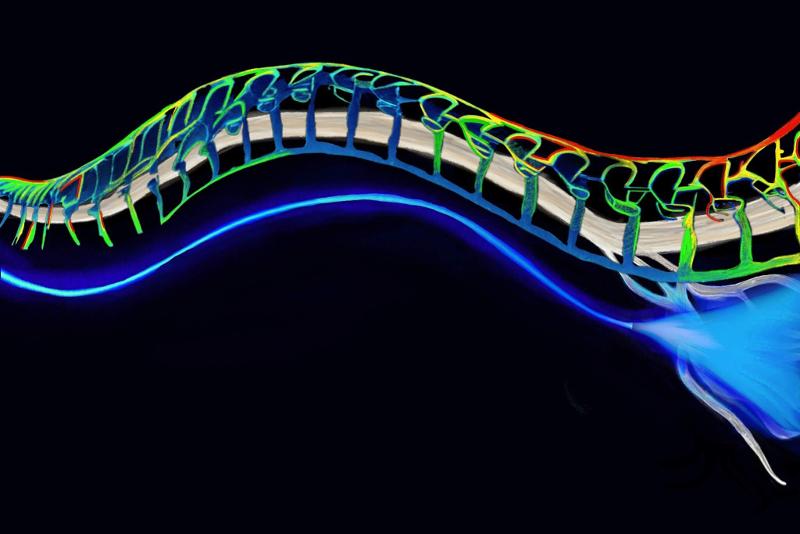Peripheral nerve disorders can cause debilitating symptoms and impact daily life. In a groundbreaking development, researchers have harnessed the power of flexible hydrogel fibers to study and manipulate peripheral nerves in animal models. By leveraging optogenetics, a technique that uses light to control cells, these hydrogel fibers enable precise activation and inhibition of peripheral nerves without hindering natural movement. This article delves into the novel approach, the challenges it overcomes, and the exciting possibilities it holds for advancing our understanding of peripheral nerve disorders.
Optogenetics: Illuminating the Possibilities
Explore the power of optogenetics in studying peripheral nerve disorders.
Optogenetics has revolutionized neuroscience by allowing precise control of selected cell populations using light. However, applying this technique to peripheral nerves posed unique challenges due to mechanical strain during movement. Enter flexible hydrogel fibers, which offer a solution to this problem.
By implanting hydrogel fibers onto peripheral nerves, researchers can optogenetically activate or inhibit these nerves without impeding natural locomotion. This breakthrough enables a deeper understanding of peripheral nerve disorders and paves the way for potential therapeutic interventions.
Hydrogel Fibers: A Soft and Resilient Tool
Discover the unique properties of hydrogel fibers and their role in peripheral nerve research.
Traditional light-delivery devices made of rigid materials can damage soft tissues and hinder natural animal behaviors. Hydrogel fibers, on the other hand, offer optical transparency and tunable mechanical properties.
Researchers have optimized hydrogel fibers to be fatigue-resistant, ensuring their durability against repeated stretching. With low optical losses, high stretchability, and resilience, these fibers provide a safe and effective means of studying peripheral nerves in animal models.
Unleashing the Potential: Inhibiting Chronic Pain
Learn how hydrogel fibers can be used to inhibit chronic pain in animal models.
In a mouse model of chronic inflammatory pain, researchers successfully inhibited sciatic pain using hydrogel fibers and a pulsed laser. By optogenetically modulating the peripheral nerves, the researchers were able to provide relief from pain without impeding the animal's natural movement.
This breakthrough holds promise for developing novel pain management strategies that target peripheral nerves, potentially offering a non-invasive and precise approach to treating chronic pain in the future.
Expanding the Possibilities: Future Applications
Explore the potential applications of hydrogel fibers beyond peripheral nerve research.
The use of hydrogel fibers opens up new avenues for studying and manipulating other mobile organs, such as the heart and gastrointestinal system. Customized fiber designs could enable the delivery of light to these organs, allowing for targeted interventions and investigations.
Researchers are actively working on scaling up the synthesis and fabrication of hydrogel fibers to accommodate larger animals and even primates. This exciting development holds promise for a wide range of applications in neuroscience and biomedical research.
Conclusion
The development of flexible hydrogel fibers has revolutionized the study of peripheral nerve disorders. By leveraging the power of optogenetics, researchers can now precisely manipulate peripheral nerves without impeding natural movement. These hydrogel fibers offer a safe and effective tool for investigating the complexities of peripheral nerve disorders and hold promise for future therapeutic interventions.
FQA
How do hydrogel fibers work in studying peripheral nerve disorders?
Hydrogel fibers are implanted onto peripheral nerves and can be used to optogenetically activate or inhibit these nerves without hindering natural movement. This allows researchers to study the function and behavior of peripheral nerves in animal models.
What are the advantages of using hydrogel fibers over traditional light-delivery devices?
Unlike rigid materials, hydrogel fibers are soft and resilient, minimizing damage to soft tissues and enabling natural animal behaviors. They have low optical losses, high stretchability, and fatigue resistance, making them an ideal tool for studying peripheral nerves.
Can hydrogel fibers be used for pain management?
Yes, hydrogel fibers have shown promise in inhibiting chronic pain in animal models. By optogenetically modulating peripheral nerves, researchers were able to provide pain relief without impeding natural movement. This opens up possibilities for developing targeted pain management strategies in the future.
What are the future applications of hydrogel fibers?
Hydrogel fibers have the potential to be used in studying and manipulating other mobile organs, such as the heart and gastrointestinal system. Customized fiber designs could enable targeted interventions and investigations in these areas, expanding our understanding of various physiological processes.

